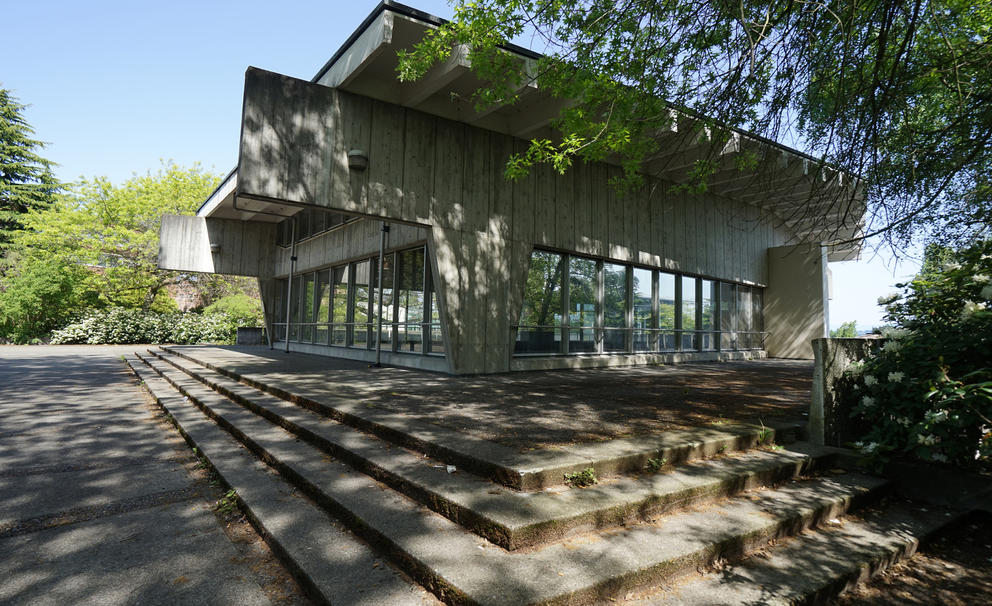David sometimes beats Goliath, but usually Goliath wins. Outgunned and out financed, preservation advocates have given up on seeking a stay of execution for More Hall Annex, the historic structure on the University of Washington campus otherwise known at the Nuclear Reactor Building.
The UW wants to tear down the structure, which is on the National Register of Historic Places, to make way for a second Computer Science and Engineering building (CSEII). The proposal has met resistance from preservationists, who want the building protected under the city’s landmarks ordinance, but in April, the UW won a court case exempting it from the ordinance, and since then, resistance has crumbled.
The city is appealing the court ruling, but did not seek to halt demolition. Now, preservation groups have decided to pass on seeking a stay as well. The problem: the cost of posting a bond to compensate the UW for damages related to a delay if the appeal fails. That’s on top of thousands more in potential legal fees.
Chris Moore of the Washington Trust for Historic Preservation says the preservation groups simply don’t have the money or collateral to cover that potential liability. “It was essentially a risk management decision,” says Moore.
University spokesperson Sally Clark says the school has not finalized a timetable, but she expects the structure to come down this summer, once UW has received a demolition permit.
If the building does fall, it will be the end of a long fight. The volunteer preservation group, Docomomo-WeWa, which focuses on protecting 20th century modern architecture in the region, had submitted an application for landmark status to the city’s landmarks board. The Nuclear Reactor Building would have almost certainly qualified for landmark status, likely foiling the UW’s plans to build a new facility on the site.
So late last year, the UW filed suit against the city, saying that the city’s landmarks ordinance doesn’t apply on its main campus.
While the city of Seattle and the UW have staff attorneys to handle such matters, small “Davids” like Docomomo do not. The Washington Trust and Historic Seattle, both nonprofits, joined the suit representing solidarity of opinion that the building should be protected. Still, their collective resources are limited: The three preservation organizations have a combined operating budget of less than $3 million; the UW’s annual operating and research budget is upwards of $6 billion.
But opposition has sprung up from another source. UW faculty members are circulating a petition directed to UW Regents Chair William Ayer, retired chair of the Alaska Air Group, protesting the plan to cut down 44 trees for the construction project. The petition claims that the CSEII project at the More Hall Annex site violates the UW Campus Master Plan. That plan, in effect until 2018, calls for open space in the area designated for the project.
The petitioners request that the university stay demolition of the nuke building and seek a new plan for CSEII at an alternative site. Ann Mescher, an associate professor of mechanical engineering, who is circulating the petition, says that many faculty members in the departments of Mechanical, Industrial, and Civil and Environmental engineering are unhappy with the impacts of the project on adjacent More Hall.
Jeffrey Karl Ochsner, professor in the Department of Architecture and an expert on Seattle architectural history, raised similar concerns in response to a draft environmental impact statement on the project. He noted that constructing CSEII on the More Hall Annex site is contrary to the 2003 Master Plan, and advocated for the importance of preserving a National Historic Register the building.
Nonetheless, the project went through a final environmental impact statement, and the UW Regents approved it. The UW says CSEII is not in violation of its master plan.
In the past, the university has generally worked cooperatively with the city on development projects, including submitting some to landmark review. But in its lawsuit over the nuke building, it argued that, not only is it exempt from the city’s landmarks ordinance, but that its main campus is effectively exempt from all local land-use regulations and that state law and the state constitution give institutions of higher learning a special status.
The city acknowledges the relationship with the UW is generally cooperative, but is not willing to cede regulatory authority, thus the appeal. The appeal will likely be heard in early in 2017, but the building will almost certainly have been demolished by then.
As for the current on-campus effort to get the UW to reconsider its plans, given the university’s sweeping arguments against local control of its activities, it is unlikely that objections to its deviance from its own master plan would deter it from moving ahead. The Washington Trust’s Moore says he’s sympathetic with the last-ditch efforts, but adds, “It’s a long shot.”
Of course, long shots are the staple of David’s arsenal, but by definition they rarely work.


